光电子学作业
- 格式:docx
- 大小:21.81 KB
- 文档页数:4
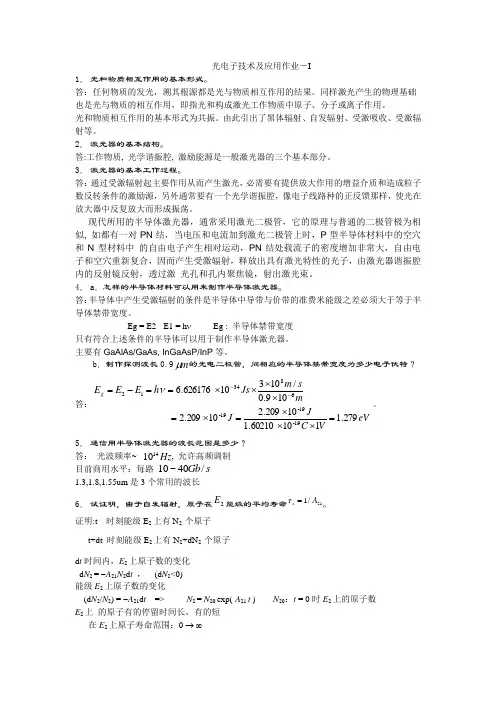
光电子技术及应用作业-I1. 光和物质相互作用的基本形式。
答:任何物质的发光,溯其根源都是光与物质相互作用的结果。
同样激光产生的物理基础 也是光与物质的相互作用,即指光和构成激光工作物质中原子、分子或离子作用。
光和物质相互作用的基本形式为共振。
由此引出了黑体辐射、自发辐射、受激吸收、受激辐射等。
2. 激光器的基本结构。
答:工作物质, 光学谐振腔, 激励能源是一般激光器的三个基本部分。
3. 激光器的基本工作过程。
答:通过受激辐射起主要作用从而产生激光,必需要有提供放大作用的增益介质和造成粒子数反转条件的激励源,另外通常要有一个光学谐振腔,像电子线路种的正反馈那样,使光在放大器中反复放大而形成振荡。
现代所用的半导体激光器,通常采用激光二极管,它的原理与普通的二极管极为相似, 如都有一对PN 结,当电压和电流加到激光二极管上时,P 型半导体材料中的空穴和N 型材料中 的自由电子产生相对运动,PN 结处载流子的密度增加非常大,自由电子和空穴重新复合,因而产生受激辐射,释放出具有激光特性的光子,由激光器谐振腔内的反射镜反射,透过激 光孔和孔内聚焦镜,射出激光束。
4. a .怎样的半导体材料可以用来制作半导体激光器。
答:半导体中产生受激辐射的条件是半导体中导带与价带的准费米能级之差必须大于等于半导体禁带宽度。
Eg = E2 - E1 = h ν Eg : 半导体禁带宽度只有符合上述条件的半导体可以用于制作半导体激光器。
主要有GaAlAs/GaAs, InGaAsP/InP 等。
b .制作探测波长0.9m μ的光电二极管,问相应的半导体禁带宽度为多少电子伏特?答:eV VC JJ msm Js h E E E g 279.111060210.110209.210209.2 109.0/10310626176.619-19-19-683412=⨯⨯⨯=⨯=⨯⨯⨯⨯==-=--ν。
5. 通信用半导体激光器的波长范围是多少? 答: 光波频率~ , 允许高频调制 目前商用水平:每路 1.3,1.8,1.55um 是3个常用的波长6. 试证明,由于自发辐射,原子在2E 能级的平均寿命21/1A s =τ。
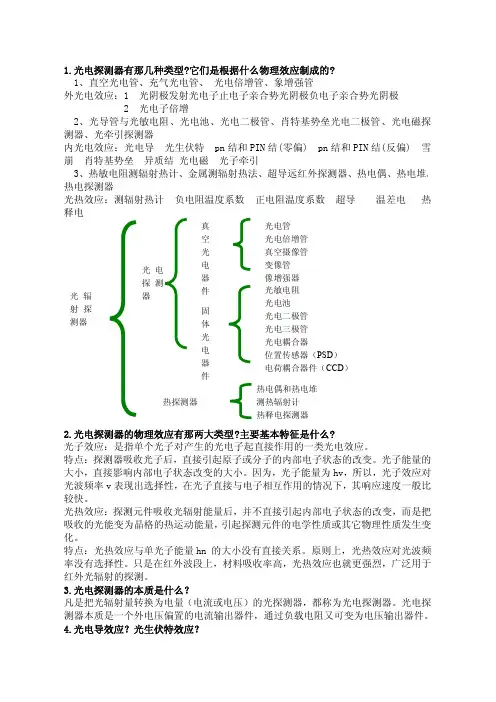
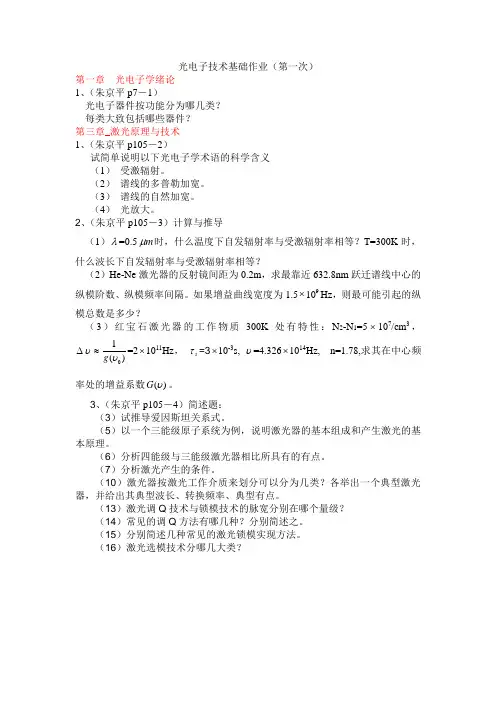
光电子技术基础作业(第一次)第一章 光电子学绪论1、(朱京平p7-1)光电子器件按功能分为哪几类?每类大致包括哪些器件?第三章_激光原理与技术1、(朱京平p105-2)试简单说明以下光电子学术语的科学含义(1) 受激辐射。
(2) 谱线的多普勒加宽。
(3) 谱线的自然加宽。
(4) 光放大。
2、(朱京平p105-3)计算与推导(1)λ=0.5m μ时,什么温度下自发辐射率与受激辐射率相等?T=300K 时,什么波长下自发辐射率与受激辐射率相等?(2)He-Ne 激光器的反射镜间距为0.2m ,求最靠近632.8nm 跃迁谱线中心的纵模阶数、纵模频率间隔。
如果增益曲线宽度为1.5⨯910Hz ,则最可能引起的纵模总数是多少?(3)红宝石激光器的工作物质300K 处有特性:N 2-N 1=5⨯107/cm 3,∆υ≈01()g υ=2⨯1011Hz , s τ=3⨯10-3s, υ=4.326⨯1014Hz, n=1.78,求其在中心频率处的增益系数()G υ。
3、(朱京平p105-4)简述题:(3)试推导爱因斯坦关系式。
(5)以一个三能级原子系统为例,说明激光器的基本组成和产生激光的基本原理。
(6)分析四能级与三能级激光器相比所具有的有点。
(7)分析激光产生的条件。
(10)激光器按激光工作介质来划分可以分为几类?各举出一个典型激光器,并给出其典型波长、转换频率、典型有点。
(13)激光调Q 技术与锁模技术的脉宽分别在哪个量级?(14)常见的调Q 方法有哪几种?分别简述之。
(15)分别简述几种常见的激光锁模实现方法。
(16)激光选模技术分哪几大类?。
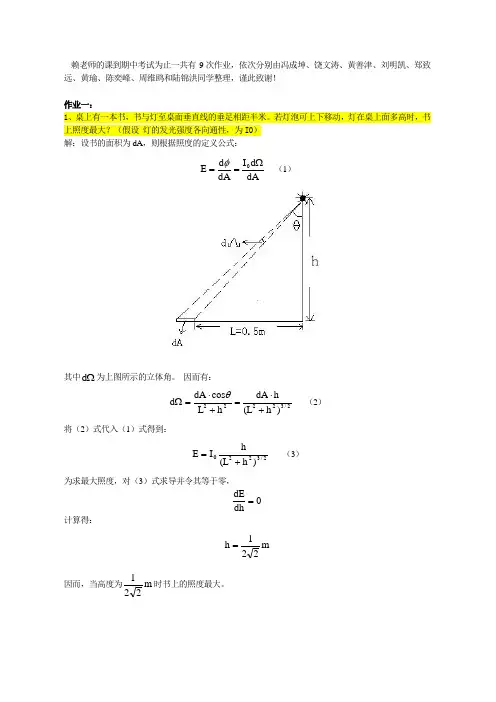
赖老师的课到期中考试为止一共有9次作业,依次分别由冯成坤、饶文涛、黄善津、刘明凯、郑致远、黄瑜、陈奕峰、周维鸥和陆锦洪同学整理,谨此致谢!作业一:1、桌上有一本书,书与灯至桌面垂直线的垂足相距半米。
若灯泡可上下移动,灯在桌上面多高时,书上照度最大?(假设 灯的发光强度各向通性,为I0) 解:设书的面积为dA ,则根据照度的定义公式:dAd I dA d E 0Ω==φ (1)其中Ωd 为上图所示的立体角。
因而有:2/32222)h (L hdA h L cos dA d +⋅=+⋅=Ωθ (2) 将(2)式代入(1)式得到:2/3220)h (L hI E += (3) 为求最大照度,对(3)式求导并令其等于零,0dhdE= 计算得:m 221h =因而,当高度为m 221时书上的照度最大。
2、设He-Ne 激光器中放电管直径为1mm ,发出波长为6328埃的激光束,全发散角为θ=10-3rad ,辐射通量为3mW ,视见函数取 V(6328)=0.24,求: (1)光通量,发光强度,沿轴线方向的亮度?(2)离激光器10米远处观察屏上照明区中心的照度?(3)若人眼只宜看一熙提的亮度,保护眼镜的透射系数应为多少? 解:(1)光通量:lm 49.010324.0638V K 3m v =⨯⨯⨯=Φ⋅⋅=Φ-θ 发光强度:cd 1024.64d d I 52vv ⨯≈Φ=ΩΦ=θπ 亮度:211235m /cd 1059.7)10(41024.6dAcos dI L ⨯≈⨯⨯==-πθ轴(2)由题意知,10米远处的照明区域直径为: m 101010L D 23--=⨯=⋅=θ从而照度为:lx 9.6238)10(4149.0D 4E 222v=⨯⨯=Φ=-ππ(3)透射率:81141026.11095.710L 1T -⨯≈⨯==轴(熙提)作业二1、说明蓝色火焰与黄色火焰的色温谁高,为什么? 答:色温是用黑体的温度来标度普通热辐射源的温度。
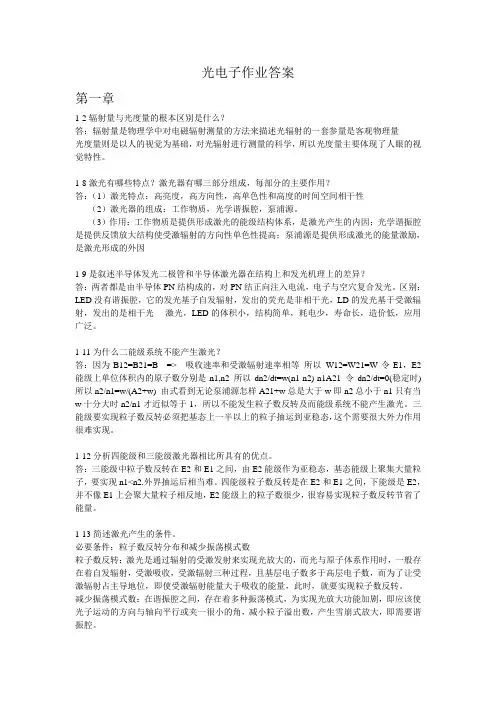
光电子作业答案第一章1-2辐射量与光度量的根本区别是什么?答:辐射量是物理学中对电磁辐射测量的方法来描述光辐射的一套参量是客观物理量光度量则是以人的视觉为基础,对光辐射进行测量的科学,所以光度量主要体现了人眼的视觉特性。
1-8激光有哪些特点?激光器有哪三部分组成,每部分的主要作用?答:(1)激光特点:高亮度,高方向性,高单色性和高度的时间空间相干性(2)激光器的组成:工作物质,光学谐振腔,泵浦源。
(3)作用:工作物质是提供形成激光的能级结构体系,是激光产生的内因;光学谐振腔是提供反馈放大结构使受激辐射的方向性单色性提高;泵浦源是提供形成激光的能量激励,是激光形成的外因1-9是叙述半导体发光二极管和半导体激光器在结构上和发光机理上的差异?答:两者都是由半导体PN结构成的,对PN结正向注入电流,电子与空穴复合发光。
区别:LED没有谐振腔,它的发光基子自发辐射,发出的荧光是非相干光,LD的发光基于受激辐射,发出的是相干光----激光,LED的体积小,结构简单,耗电少,寿命长,造价低,应用广泛。
1-11为什么二能级系统不能产生激光?答:因为B12=B21=B => 吸收速率和受激辐射速率相等所以W12=W21=W令E1,E2能级上单位体积内的原子数分别是n1,n2 所以dn2/dt=w(n1-n2)-n1A21 令dn2/dt=0(稳定时) 所以n2/n1=w/(A2+w) 由式看到无论泵浦源怎样A21+w总是大于w即n2总小于n1只有当w十分大时n2/n1才近似等于1,所以不能发生粒子数反转及而能级系统不能产生激光。
三能级要实现粒子数反转必须把基态上一半以上的粒子抽运到亚稳态,这个需要很大外力作用很难实现。
1-12分析四能级和三能级激光器相比所具有的优点。
答:三能级中粒子数反转在E2和E1之间,由E2能级作为亚稳态,基态能级上聚集大量粒子,要实现n1<n2.外界抽运后相当难。
四能级粒子数反转是在E2和E1之间,下能级是E2,并不像E1上会聚大量粒子相反地,E2能级上的粒子数很少,很容易实现粒子数反转节省了能量。
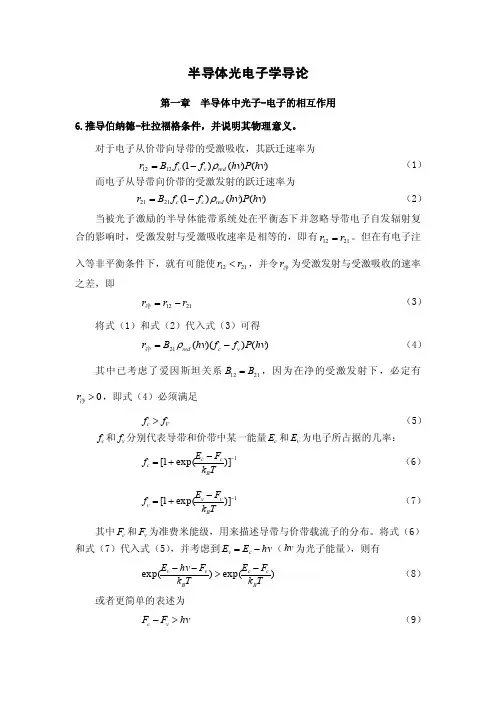
半导体光电子学导论第一章 半导体中光子-电子的相互作用6.推导伯纳德-杜拉福格条件,并说明其物理意义。
对于电子从价带向导带的受激吸收,其跃迁速率为)()()1(1212hv P hv f f B r red v v ρ-= (1) 而电子从导带向价带的受激发射的跃迁速率为)()()1(2121hv P hv f f B r red c c ρ-= (2)当被光子激励的半导体能带系统处在平衡态下并忽略导带电子自发辐射复合的影响时,受激发射与受激吸收速率是相等的,即有2112r r =。
但在有电子注入等非平衡条件下,就有可能使2112r r <,并令净r 为受激发射与受激吸收的速率之差,即2112r r r -=净 (3)将式(1)和式(2)代入式(3)可得)())((21hv P f f hv B r v c red -=ρ净 (4) 其中已考虑了爱因斯坦关系2112B B =,因为在净的受激发射下,必定有0>净r ,即式(4)必须满足V c f f > (5) c f 和v f 分别代表导带和价带中某一能量c E 和v E 为电子所占据的几率: 1)]exp(1[--+=Tk F E f B c c c (6) 1)]exp(1[--+=Tk F E f B v v v (7) 其中c F 和v F 为准费米能级,用来描述导带与价带载流子的分布。
将式(6)和式(7)代入式(5),并考虑到hv E E c v -=(hv 为光子能量),则有 )exp()exp(Tk F E T k F hv E B c c B v v ->-- (8) 或者更简单的表述为hv F F v c >- (9)对于带间跃迁的受激发射,需满足g E hv ≥,故式(9)还可以写为g E F ≥∆ (10) 式(7)及其演变式(8)和(9)即伯纳德-杜拉福格条件。
它是半导体中产生受激发射的必要条件,也可称为半导体激光器的粒子数反转条件,是半导体激光器得以成功的理论基础。
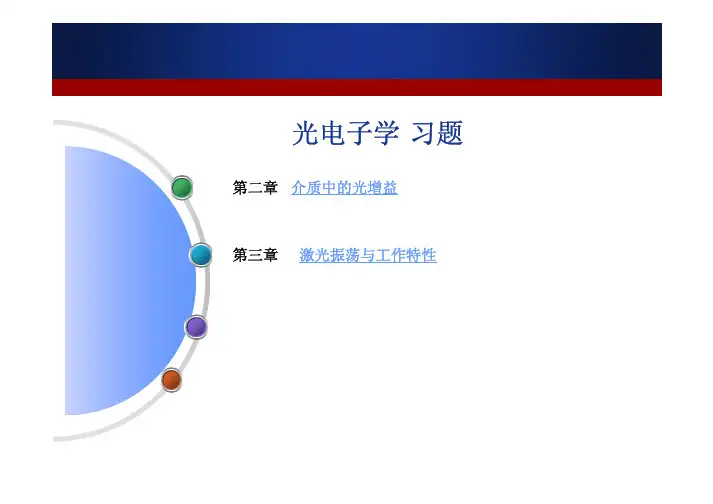
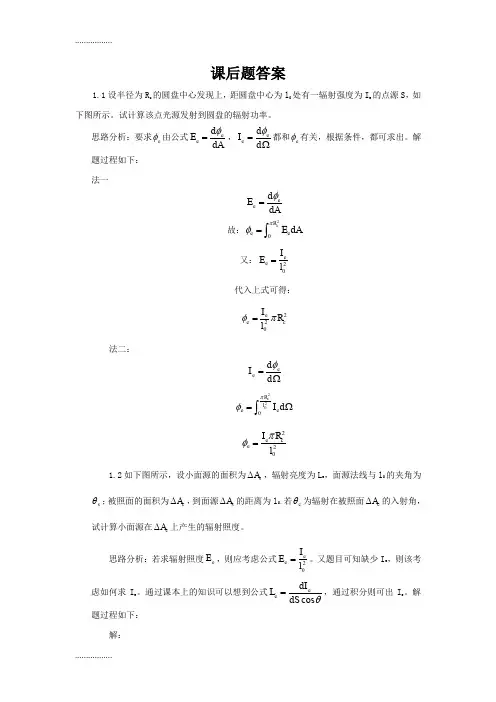
课后题答案1.1设半径为R c 的圆盘中心发现上,距圆盘中心为l 0处有一辐射强度为I e 的点源S ,如下图所示。
试计算该点光源发射到圆盘的辐射功率。
思路分析:要求e φ由公式e e d E dA φ=,ee d I d φ=Ω都和e φ有关,根据条件,都可求出。
解题过程如下: 法一ee d E dAφ=故:20cR e e E dA πφ=⎰又:20ee I E l =代入上式可得:220e e c I R l φπ=法二:ee d I d φ=Ω220c R l e e Id πφ=Ω⎰220e c e I R l πφ=1.2如下图所示,设小面源的面积为s A ∆,辐射亮度为L e ,面源法线与l 0的夹角为s θ;被照面的面积为c A ∆,到面源s A ∆的距离为l 0。
若c θ为辐射在被照面c A ∆的入射角,试计算小面源在c A ∆上产生的辐射照度。
思路分析:若求辐射照度e E ,则应考虑公式20ee I E l =。
又题目可知缺少I e ,则该考虑如何求I e 。
通过课本上的知识可以想到公式cos ee dI L dS θ=,通过积分则可出I e 。
解题过程如下:解:20ee I E l =由cos ee dI L dS θ=可得cos sA e e I L dS θ∆=⎰= cos e s L A θ∆,故:2200cos e e se I L A E l l θ∆== 1.3假如有一个按朗伯余弦定律发射辐射的大扩展源(如红外装置面对的天空背景),其各处的辐射亮度L e 均相同。
试计算该扩展源在面积为A d 的探测器表面上产生的辐射照度。
思路分析:题目中明确给出扩展源是按朗伯余弦定律发射辐射的,且要求辐射照度E e ,由公式ee d E dAφ=可知,要解此题需求出e d φ,而朗伯体的辐射通量为cos e e e d L dS d L dS φθπ=Ω=⎰,此题可解。
解题过程如下:解:ee d E dAφ=cos e e e d L dS d L dS φθπ=Ω=⎰e e e L dSE L dAππ== 1.4霓虹灯发的光是热辐射吗?答:霓虹灯发光是以原子辐射产生的光辐射,属于气体放电,放电原理后面章节会涉及到。

一、选择题1、光探测器是光纤传感器构成的一个重要部分,它的性能指标将直接影响传感器的性能。
光纤传感器对光探测器的要求包括以下那几个?(A B D)A. 线行好,按比例地将光信号转换为电信号B. 灵敏度高,能敏度微小的输入光信号C. 产品结构简单,易维护D. 性能稳定,噪声小2、红外探测器的性能参数是衡量其性能好坏的依据。
其中响应波长范围(或称光谱响应),是表示探测器的( B )相应率与入射的红外辐射波长之间的关系。
A. 电流B. 电压C. 功率D. 电阻3、光子探测是利用某些半导体材料在入射光的照下,产生( A )。
使材料的电学性质发生变化。
通过测量电学性质的变化,可以知道红外辐射的强弱。
A. 光子效应B. 霍尔效应C. 热电效应D. 压电效应4、当红外辐射照射在某些半导体材料表面上时,半导体材料中有些电子和空穴可以从原来不导电的束缚状态变为能导电的自由状态,使半导体的导电率增加,这种现象叫( B )A. 光电效应B. 光电导现象C. 热电效应D. 光生伏特现象5、利用温差电势现象制成的红外探测器称为( A )红外探测器,因其时间常数较大,响应时间较长,动态特性较差,调制频率应限制在10Hz以下。
A. 热电偶型B. 热释电型C. 热敏电阻型D. 热电动型6、在光线作用下,半导体的电导率增加的现象属于( D )A. 外光电效应B. 内光电效应C. 光电发射D. 光导效应二、判断题1、当光辐射照在某些材料的表面上时,若入射光的光子能量足够大,就能使材料的电子逸出表面,向外发射出电子,这种现象叫内光电效应或光电子发射效应。
(×)2、光电池是利用光生伏特效应,直接将光能转换为电能的光电器件。
(√)3、当恒定的红外辐射照射在热释电探测器上时,探测器才有电信号输出。
(×)三、填空题(20分,2分/题)1、红外辐射俗称红外线,它是一种人眼看不见的光线,但实际上它与其他任何光线一样,也是一种客观存在的物质。
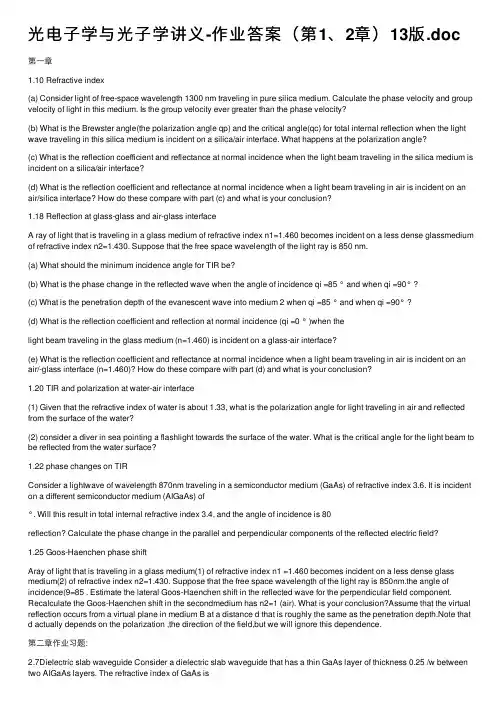
光电⼦学与光⼦学讲义-作业答案(第1、2章)13版.doc 第⼀章1.10 Refractive index(a) Consider light of free-space wavelength 1300 nm traveling in pure silica medium. Calculate the phase velocity and group velocity of light in this medium. Is the group velocity ever greater than the phase velocity?(b) What is the Brewster angle(the polarization angle qp) and the critical angle(qc) for total internal reflection when the light wave traveling in this silica medium is incident on a silica/air interface. What happens at the polarization angle?(c) What is the reflection coefficient and reflectance at normal incidence when the light beam traveling in the silica medium is incident on a silica/air interface?(d) What is the reflection coefficient and reflectance at normal incidence when a light beam traveling in air is incident on an air/silica interface? How do these compare with part (c) and what is your conclusion?1.18 Reflection at glass-glass and air-glass interfaceA ray of light that is traveling in a glass medium of refractive index n1=1.460 becomes incident on a less dense glassmedium of refractive index n2=1.430. Suppose that the free space wavelength of the light ray is 850 nm.(a) What should the minimum incidence angle for TIR be?(b) What is the phase change in the reflected wave when the angle of incidence qi =85 ° and when qi =90° ?(c) What is the penetration depth of the evanescent wave into medium 2 when qi =85 ° and when qi =90° ?(d) What is the reflection coefficient and reflection at normal incidence (qi =0 ° )when thelight beam traveling in the glass medium (n=1.460) is incident on a glass-air interface?(e) What is the reflection coefficient and reflectance at normal incidence when a light beam traveling in air is incident on an air/-glass interface (n=1.460)? How do these compare with part (d) and what is your conclusion?1.20 TIR and polarization at water-air interface(1) Given that the refractive index of water is about 1.33, what is the polarization angle for light traveling in air and reflected from the surface of the water?(2) consider a diver in sea pointing a flashlight towards the surface of the water. What is the critical angle for the light beam to be reflected from the water surface?1.22 phase changes on TIRConsider a lightwave of wavelength 870nm traveling in a semiconductor medium (GaAs) of refractive index 3.6. It is incident on a different semiconductor medium (AIGaAs) of°. Will this result in total internal refractive index 3.4, and the angle of incidence is 80reflection? Calculate the phase change in the parallel and perpendicular components of the reflected electric field?1.25 Goos-Haenchen phase shiftAray of light that is traveling in a glass medium(1) of refractive index n1 =1.460 becomes incident on a less dense glass medium(2) of refractive index n2=1.430. Suppose that the free space wavelength of the light ray is 850nm.the angle of incidence(9=85 . Estimate the lateral Goos-Haenchen shift in the reflected wave for the perpendicular field component. Recalculate the Goos-Haenchen shift in the secondmedium has n2=1 (air). What is your conclusion?Assume that the virtual reflection occurs from a virtual plane in medium B at a distance d that is roughly the same as the penetration depth.Note that d actually depends on the polarization ,the direction of the field,but we will ignore this dependence.第⼆章作业习题:2.7Dielectric slab waveguide Consider a dielectric slab waveguide that has a thin GaAs layer of thickness 0.25 /w between two AIGaAs layers. The refractive index of GaAs is3.6 and that of the AIGaAs layers is 3.40. What is the cut-off wavelength beyond which only a single mode can propagate in the waveguide, assuming that the refractive index does not vary greatly with thewavelength? If a radiation of wavelength 860 nm (corresponding to bandgap radiation) is propagating in the GaAs layer, what is the penetration of the evanescent wave into the AIGaAs layer? What is the mode field width (MFW) of this radiation? Point out the effect of change of radiation wavelength (为on the MFW.2.9 Dielectric slab waveguide Consider a planar dielectric waveguide with a core thickness 10/m,ni=1.4446, n2=1.4440. Calculate the V -number, the mode angle 劣for m=0 (use a graphical solution, if necessary), penetration depth, and mode field distance (MFW=2 c(^2 9, for light wavelengths of 1.0 /xn and 5 /jn. What is your conclusion? Compare your MFW calculationwith 2?o =2a (V +1 )/V .The model angle 3is given as &=88.85?for ^=1 /m and ^=88.72 ?for ^=1.5 仰for the fundamental mode m=0.2.10 A multimode fibe r Consider a multimode fiber with a core diameter of 60 /m, core refractive index of 1.47, and a cladding refractive index of 1.45 both at 870 nm. Consider operating this fiber at ^=870nm.(e) Calculate the numerical aperture.(f) Find out the normalized core-cladding index difference.(g) Calculate the V-number for the fiber and estimate the number of guided modes.(h) Calculate the wavelength beyond which the fiber becomes single-mode.(i) Calculate the modal dispersion △ T and hence the bit rate x distance product.2.12 Single mode fiber Consider a fiber with a S1O2-13.5% GeOz core of diameter of 6 Wi and refractive index of 1.47 and a cladding refractive index of 1.46 both refractive indices at 1300 nm where the fiber is to be operated using a laser source with a half maximum width (FWHM) of 2 nm.. (j) Calculate the V -number for the fiver.(k) what is the maximum allowed diameter of the core that maintains oprations in single-mode?(l) Calculate the wavelength below which the fiber becomes multimode.(m) C alculate the numerical aperture.(n) Calculate the maximum acceptance angle.(o) Obtain the material dispersion and wavelength dispersion and hence estimate the bit rate x distance product ( B x L) of the fiber.。

半导体光电子学导论第二章 异质结2.若异质结由n (111,,φχg E )型和p (222,,φχg E )型半导体构成,并有21g g E E <、21χχ>、21φφ<,试画出n P 能带图。
4. 推导出pN 异质结电容j C 与所加正向偏压的关系,j C 的大小对半导体光电子器件的应用产生什么影响?在空间电荷区内,电中性条件成立,因此可以得到结电容的表达式为2/1221121211])(2[)(DD A D A P A D j V N N N eN x eN dV d C εεεε+== 当在异质结两边加上正向电压(即p 型相当于N 型半导体加上正电压)a V 后,它在结面两边空间电荷区上的压降分别为1V 和2V ,这时势垒高度就由原来的D eV 降低到)]()[()(2211V V V V e V V e D D a D -+-=-。
只要用)(a D V V -代替D V ,用)(11V V D -和)(22V V D -分别代替1D V 和2D V ,上式依然成立,因此便得到结电容j C 与所加正向偏压a V 的关系2/122112121]))((2[a D D A D A j V V N N N eN C -+=εεεε 结电容直接影响器件在高频情况下的使用。
5. 用弗伽定律计算As Al Ga x x -1半导体当4.0=x 时的晶格常数,并求出与GaAs 的晶格失配率。
根据弗伽定律Ac AD BC BD ABCD a y x a x y a y x xya a )1)(1()1()1(--+-+-+=易知在这里1=y ,查表得661.5==AlAs BD a a ,654.5==GaAs AD a a ,代入弗伽公式计算得)A (526.4654.5)4.01(1661.514.0)1(=⨯-⨯+⨯⨯=-++=ADBD ABCD a x y xya a6. 探讨在Si 衬底上生长出GaAs 异质结的可能性。
作业一答案1. [3分] 设InP 在室温(300K )下的电子和空穴的有效质量分别为0.077m 0和0.61m 0,禁带宽度为1.35eV 。
(a ) 计算导带和价带的有效态密度; (b ) 计算本征载流子浓度;(c ) 一个掺杂了浓度为1017 S 原子/cm 3的样品,它的平衡态空穴密度为多少?它的费米能级相对于本征费米能级的距离是多少?(d ) 一个p-n 结的掺杂浓度为N a =1017cm -3,N d =1016cm -3。
分别计算p 区和n 区的多数载流子和少数载流子的浓度,并计算该p-n 结的扩散势能和耗尽区宽度。
答:(a )导带有效态密度:33*31232217333432(2)2(20.0779.1110 1.3810300)5.3610(6.62610)ππ----⨯⨯⨯⨯⨯⨯⨯===⨯⨯c m kT N cm h价带有效态密度:33*31232219333432(2)2(20.619.1110 1.3810300)1.210(6.62610)ππ----⨯⨯⨯⨯⨯⨯⨯===⨯⨯v m kT N cm h(b )本征载流子浓度19231.351.6101117197321.381030022()exp()(5.3610 1.210) 1.19102--⨯⨯--⨯⨯⨯=-=⨯⨯⨯=⨯g i c v E n N N ecm kT(c )173010-≈=d n N cm平衡态空穴密度()272330171.1910 1.41010--⨯===⨯in p cm n175710ln 8.61710300ln 0.591.1910--==⨯⨯⨯=⨯d i F i N E E kT eV n(d )p 区多数载流子为空穴 173010-==a p N cm少数载流子()272330171.1910 1.41010--⨯===⨯in n cm pn 区多数载流子为电子, 0n =d N =16310cm -少数载流子()272230160 1.1910 1.41010--⨯===⨯in p cm np-n 结的扩散势能1617502721010(ln )8.61710300ln 1.12(1.1910)-⨯===⨯⨯⨯=⨯D A i N N E qV kT eV n0 1.12=V V耗尽区宽度1112022192322211212.48.85410 1.1211[()][()]0.411.6101010εμ--⨯⨯⨯⨯=+=+=⨯d a V W m q N N2. [1分] 一个光源在波长范围0.4~2.0μm 内发出均匀的光强。
第一章1.10 Refractive index(a) Consider light of free-space wavelength 1300 nm traveling in pure silica medium. Calculate the phase velocity and group velocity of light in this medium. Is the group velocity ever greater than the phase velocity?(b) What is the Brewster angle(the polarization angle qp) and the critical angle(qc) for total internal reflection when the light wave traveling in this silica medium is incident on a silica/air interface. What happens at the polarization angle?(c) What is the reflection coefficient and reflectance at normal incidence when the light beam traveling in the silica medium is incident on a silica/air interface?(d) What is the reflection coefficient and reflectance at normal incidence when a light beam traveling in air is incident on an air/silica interface? How do these compare with part (c) and what is your conclusion?1.18 Reflection at glass-glass and air-glass interfaceA ray of light that is traveling in a glass medium of refractive index n1=1.460 becomes incident on a less dense glass medium of refractive index n2=1.430. Suppose that the free space wavelength of the light ray is 850 nm.(a) What should the minimum incidence angle for TIR be?(b) What is the phase change in the reflected wave when the angle of incidence qi =85°and when qi =90°?(c) What is the penetration depth of the evanescent wave into medium 2 when qi =85°and when qi =90°?(d) What is the reflection coefficient and reflection at normal incidence (qi =0 °)when the light beam traveling in the glass medium (n=1.460) is incident on a glass-air interface? (e) What is the reflection coefficient and reflectance at normal incidence when a light beam traveling in air is incident on an air/-glass interface (n=1.460)? How do these compare with part (d) and what is your conclusion?1.20 TIR and polarization at water-air interface(1) Given that the refractive index of water is about 1.33, what is the polarization angle for light traveling in air and reflected from the surface of the water?(2) consider a diver in sea pointing a flashlight towards the surface of the water. What is the critical angle for the light beam to be reflected from the water surface?1.22 phase changes on TIRConsider a lightwave of wavelength 870nm traveling in a semiconductor medium (GaAs) of refractive index 3.6. It is incident on a different semiconductor medium (AlGaAs) of refractive index 3.4, and the angle of incidence is 80o. Will this result in total internal reflection? Calculate the phase change in the parallel and perpendicular components of the reflected electric field?1.25 Goos-Haenchen phase shiftAray of light that is traveling in a glass medium(1) of refractive index n1=1.460 becomesincident on a less dense glass medium(2) of refractive index n2=1.430. Suppose that the free space wavelength of the light ray is 850nm.the angle of incidence θi =85°. Estimate the lateral Goos-Haenchen shift in the reflected wave for the perpendicular field component. Recalculate the Goos-Haenchen shift in the second medium has n2=1 (air). What is your conclusion?Assume that the virtual reflection occurs from a virtual plane in medium B at a distance d that is roughly the same as the penetration depth.Note that d actually depends on the polarization ,the direction of the field,but we will ignore this dependence.第二章 作业习题:θ2.7 Dielectric slab waveguide Consider a dielectric slab waveguide that has a thin GaAs layer of thickness 0.25μm between two AlGaAs layers. The refractive index of GaAs is3.6 and that of the AlGaAs layers is 3.40. What is the cut-off wavelength beyond which only a single mode can propagate in the waveguide, assuming that the refractive index does not vary greatly with the wavelength? If a radiation of wavelength 860 nm (corresponding to bandgap radiation) is propagating in the GaAs layer, what is the penetration of the evanescent wave into the AlGaAs layer? What is the mode field width (MFW) of this radiation? Point out the effect of change of radiation wavelength (λ) on the MFW.2.9 Dielectric slab waveguide Consider a planar dielectric waveguide with a core thickness 10μm , n 1=1.4446, n 2=1.4440. Calculate the V -number, the mode angle θm for m=0 (use a graphical solution, if necessary), penetration depth, and mode field distance (MFW=2α+2δ), for light wavelengths of 1.0μm and 5μm . What is your conclusion? Compare your MFW calculation with ()0221/a V V ω=+.The model angle θ0is given as θ0=88.85ᵒ for λ=1μm and θ0=88.72ᵒ for λ=1.5μm for the fundamental mode m=0.2.10 A multimode fibe r Consider a multimode fiber with a core diameter of 60μm , core refractive index of 1.47, and a cladding refractive index of 1.45 both at 870 nm. Consider operating this fiber at λ=870n m .(a) Calculate the numerical aperture.(b) Find out the normalized core-cladding index difference.(c) Calculate the V-number for the fiber and estimate the number of guided modes.(d) Calculate the wavelength beyond which the fiber becomes single-mode.(e) Calculate the modal dispersion τ∆and hence the bit rate ⨯distance product .2.12 Single mode fiber Consider a fiber with a 2SiO -13.5%2GeO core of diameter of 6m μ and refractive index of 1.47 and a cladding refractive index of 1.46 both refractive indices at 1300 nm where the fiber is to be operated using a laser source with a half maximum width (FWHM) of 2 nm..(a) Calculate the V -number for the fiver.(b)what is the maximum allowed diameter of the core that maintains oprations in single-mode?(c) Calculate the wavelength below which the fiber becomes multimode.(d) Calculate the numerical aperture.(e) Calculate the maximum acceptance angle.(f)Obtain the material dispersion and wavelength dispersion and hence estimate the bit rate⨯) of the fiber.⨯distance product (B L。